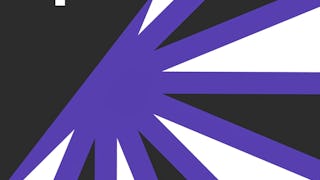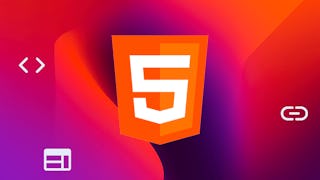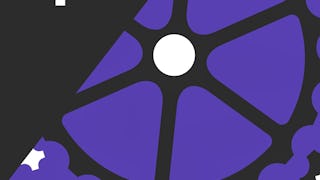Thanks to a growing number of software programs, it seems as if anyone can make a webpage. But what if you actually want to understand how the page was created? There are great textbooks and online resources for learning web design, but most of those resources require some background knowledge. This course is designed to help the novice who wants to gain confidence and knowledge.

Enjoy unlimited growth with a year of Coursera Plus for $199 (regularly $399). Save now.

Introduction to HTML5
This course is part of Web Design for Everybody: Basics of Web Development & Coding Specialization


Instructors: Colleen van Lent, Ph.D.
602,370 already enrolled
Included with
(27,832 reviews)
What you'll learn
Recognize and use common HTML5 tags.
Be aware of what an editor is and how to use one.
Compose HTML5 code that can create images and links.
Skills you'll gain
Details to know

Add to your LinkedIn profile
3 assignments
See how employees at top companies are mastering in-demand skills

Build your subject-matter expertise
- Learn new concepts from industry experts
- Gain a foundational understanding of a subject or tool
- Develop job-relevant skills with hands-on projects
- Earn a shareable career certificate

There are 3 modules in this course
This week we will uncover the "mystery" behind the Internet. What happens when you type a URL into your browser so that a webpage magically appears? What is HTML5 and what happened to HTML 1 - 4? We will also cover some practical concepts that you need to master before you begin coding your own pages.
What's included
7 videos9 readings1 assignment1 discussion prompt
This week you will need to take a deep breath and jump into coding. I will cover a large number of HTML tags, but it is important that you do more than just listen to these video and read the text book material. You need to practice (and fail!) in order to learn. Believe it or not, once you master the basic idea of using tags and attributes you will know everything you need to use any HTML5 tag. The page may not look the way you want it to look yet, but you will be able to use text, links, images, tables, and even music and videos! If you want to refer to a textbook this week for reinforcement of concepts, we will be using the Shay Howe online textbook as a reference. I will include links after the lectures, but some students prefer to read before the videos. (My preferred approach is to read/watch/read again.)
What's included
9 videos11 readings1 assignment
Okay, you created a file...what now? This week we will begin by covering the important but often overlooked concepts of validation and accessibility. Did you follow the DOM structure when you created your page? Did you use semantic tags to make sure that page viewers can access all of the information, even if they have physical or cognitive disabilities? This is knowledge you can use if you would like to pursue a career as a web accessibility specialist. Finally I will briefly cover the steps needed to post your site to the web if you decide to use something other than Replit. There are many free and paid services that you can use to get your work off your computer and on to the Internet.
What's included
8 videos9 readings1 assignment1 peer review1 app item
Earn a career certificate
Add this credential to your LinkedIn profile, resume, or CV. Share it on social media and in your performance review.
Instructors

Offered by
Explore more from Mobile and Web Development
 Status: Free Trial
Status: Free Trial Status: Free Trial
Status: Free Trial Status: Free Trial
Status: Free TrialUniversity of Michigan
Why people choose Coursera for their career




Learner reviews
27,832 reviews
- 5 stars
78.80%
- 4 stars
18.03%
- 3 stars
2.36%
- 2 stars
0.30%
- 1 star
0.49%
Showing 3 of 27832
Reviewed on Jun 16, 2017
This was at a self learning pace that allowed me to succeed. Colleen van Lent does a great job in the videos where they are short enough to not lose interest, yet enough information to easily learn.
Reviewed on Jun 2, 2017
The course is a good starter, but it could do with more material allowing you to practice the skills presented each week rather than the self-driven approach, which could be done without the class.
Reviewed on Oct 18, 2015
Perfect for someone who wants to start learning HTML5 and the entire specialization from scratch.The course is well paced, starts off easy, and seriously takes you step by step into making a web-page.

Open new doors with Coursera Plus
Unlimited access to 10,000+ world-class courses, hands-on projects, and job-ready certificate programs - all included in your subscription
Advance your career with an online degree
Earn a degree from world-class universities - 100% online
Join over 3,400 global companies that choose Coursera for Business
Upskill your employees to excel in the digital economy
Frequently asked questions
To access the course materials, assignments and to earn a Certificate, you will need to purchase the Certificate experience when you enroll in a course. You can try a Free Trial instead, or apply for Financial Aid. The course may offer 'Full Course, No Certificate' instead. This option lets you see all course materials, submit required assessments, and get a final grade. This also means that you will not be able to purchase a Certificate experience.
When you enroll in the course, you get access to all of the courses in the Specialization, and you earn a certificate when you complete the work. Your electronic Certificate will be added to your Accomplishments page - from there, you can print your Certificate or add it to your LinkedIn profile.
Yes. In select learning programs, you can apply for financial aid or a scholarship if you can’t afford the enrollment fee. If fin aid or scholarship is available for your learning program selection, you’ll find a link to apply on the description page.
More questions
Financial aid available,


